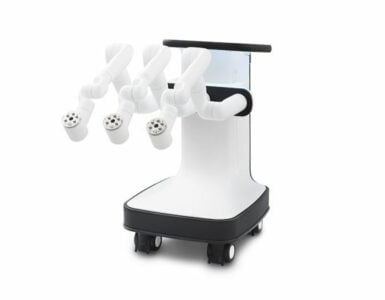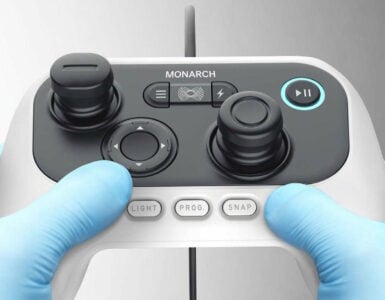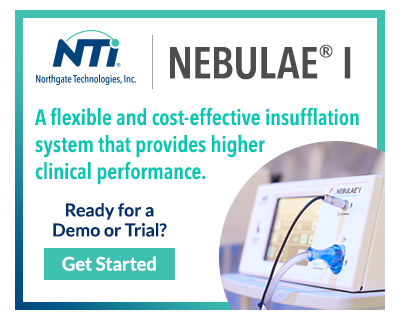Ethicon*, a Johnson & Johnson MedTech company**, announced today the first patient receiving robotic-assisted removal of kidney stones using the MONARCH™ Platform for Urology. As part of a clinical study, UCI Health, the clinical enterprise of the University of California, Irvine (UCI), used the MONARCH Platform for Urology to successfully complete the first robotically assisted electromagnetic (EM)-guided percutaneous access and mini-percutaneous nephrolithotomy (PCNL) procedure. The clinical study involves a collaboration with co-investigator, Dr. Mihir Desai from the University of Southern California (USC).***
“This clinical study is the first in the world to research and demonstrate the potential for improved navigation, access, clearance and control in mini-PCNL procedures using the MONARCH Platform for Urology,” said Dr. Jaime Landman, chair of the UCI School of Medicine Department of Urology and director of the UCI Health Kidney Stone & Kidney Disease Services.**** “In addition to potentially helping urologists achieve stone-free patients in a single procedure, this approach could help reduce the need for retreatment after kidney stone removal and decrease risks and complication rates.”
The MONARCH Platform aims to create new treatment paradigms that help improve patient’s lives as the first flexible robotic platform cleared for use in bronchoscopy and urology procedures. The MONARCH Platform for Urology allows urologists to navigate through the kidney using robotic-assistance designed for access, clearance and control using a handheld controller. It provides urologists with one platform that supports both ureteroscopic and percutaneous nephrolithotomy (PCNL) procedures.
Robotic assistance in a kidney stone removal procedure is designed to allow surgeons to precisely maintain instrument positions, providing the freedom to perform multiple tasks simultaneously. UCI Medical Center, part of UCI Health, is the first hospital in the United States to utilize the MONARCH Platform for Urology, which received 510(k) clearance by the U.S. Food and Drug Administration (FDA) in April 2022.
This first case is part of a Clinical Study led by Ethicon’s Clinical group. This study will involve collecting performance data on robotic mini-PCNL procedures to optimize the MONARCH Platform and inform training and education.
“The prevalence of kidney stones remains high, and many urologists seek a new treatment option that reduces overall retreatment and complication rates. In patients who require treatment through surgery, close to one in two will require retreatment within five years,” said Dr. Mihir Desai, USC.***
The MONARCH Platform uses a novel EM targeting platform which is designed to help urologists gain more precise access to the kidney and strives to enable urologists to achieve overall better outcomes in a single procedure, which we hope will improve the way that physicians and patients view the removal of kidney stones.
“After years of work, we are thrilled to be a part of this first clinical series which introduces a new treatment to improve outcomes for patients in need,” said Landman.****
About one in 11 Americans will experience a kidney stone in their lifetime1, and many require retreatment as kidney stones return following surgical removal2. There are a few options for removal. Ureteroscopic procedures are the most common surgical stone procedures globally but become increasingly challenging as stone size increases.3
PCNL procedures have demonstrated superior stone clearance for patients with larger kidney stones, yet they represent only 7-8% of stone procedures conducted in the U.S. today.4
Numerous barriers hinder more frequent use of PCNL. The MONARCH Platform for Urology enables urologists to overcome many of these obstacles by using unique and minimally invasive technology. When compared to standard fluoroscopic guided access techniques, the MONARCH Platform for Urology provides 80% less radiation exposure5 during percutaneous access, improved accuracy and consistency when performing percutaneous access, and fewer needle sticks when obtaining access.
- Charles D. Scales, Jr., Alexandria C. Smith, Janet M. Hanley, Christopher S. Saigal, and Urologic Diseases in America Project. “Prevalence of Kidney Stones in the United States.” ncbi.nlm.nih.gov. European Urology. European Association of Urology. 2012 July; 62(1): 160–165.
- Gregory Foster, MPH, MA, Carol Stocks, MHSA, RN, and Michael S Borofsky, MD. “Emergency Department Visits and Hospital Admissions for Kidney Stone Disease, 2009, Statistical Brief #139.” ncbi.nlm.nih.gov. Healthcare Cost and Utilization Project (HCUP) Statistical Briefs. 2012 July.
- Whitehurst L, Pietropaolo A, Geraghty R, Kyriakides R, Somani BK. Factors affecting operative time during ureteroscopy and stone treatment and its effect on outcomes: retrospective results over 6.5 years. Ther Adv Urol. 2020 Jun 23;12:1756287220934403. PMID: 32636935.
- Chung KJ, Kim JH, Min GE, Park HK, Li S, Del Giudice F, Han DH, Chung BI. Changing Trends in the Treatment of Nephrolithiasis in the Real World. J Endourol. 2019 Mar;33(3):248-253. doi: 10.1089/end.2018.0667. Epub 2019 Feb 13. PMID: 30628473.
- Humphreys M, Wymer K, Chew B, Zhen J, Elkhoury F, Sivalingam S, Dunn M, Borofsky M. Robotic Assisted Electromagnetic Guidance Minimizes Radiation Exposure in Gaining Percutaneous Access for Nephrolithotomy: A Cadaveric Study with Novices. https://www.auajournals.org/











